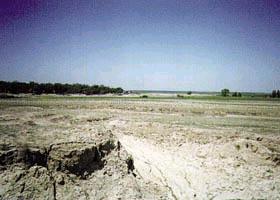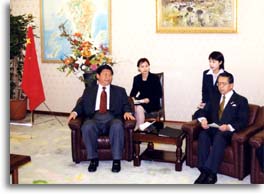 History,
Economy, and Policy between Japan and China
History,
Economy, and Policy between Japan and China
![]() History
History
On September 29, 1972, a Joint Communiqué of the Government of Japan and the Government of the People's Republic of China established a neutralization relationship between Japan and China:
Japan and China are neighboring countries, separated only by a strip of water with a long history of traditional friendship. ... The realization of the aspiration of the two peoples for the termination of the state of war and the normalization of relations between Japan and China will add a new page to the annals of relations between the two countries.
In an attempt to contribute to relaxation of tension in Asia and peace in the international community, the normalization of relations is based on principles of mutual respect for sovereignty and territory, non-aggression, non-interference in internal affairs, equality, mutual benefit, and peaceful co-existence.
On August 12, 1987, the Treaty of Peace and Friendship between Japan and the People's Republic of China reaffirmed the principles of the 1972 Joint Communiqué and the Charter of the United Nations. Again, in an attempt to contribute to peace and stability in Asia and in the world, the treaty's purpose was to solidify and develop the peaceful friendly relations between China and Japan.
Beginning in 1979, China starts to accept packages of official development assistance (ODA) and direct investment from Japan (described below).
In November 1998, the Japan-China Joint Declaration on Building a Partnership of Friendship and Cooperation for Peace and Development and the Joint Press Announcement on Strengthening Cooperation Between Japan and China Toward the 21st Century promised to build a "friendly and cooperative partnership for peace and development." The declaration stressed that Japan and China should cooperate not only for their own benefit, but in order to contribute to the international community. The press release contained 33 specific items for cooperation, through which the countries established a framework to work together toward their common goals.
![]() Economy
Economy
Trade, Direct Investment, and the WTO
Japan-China economic relations are very strong ties of mutual dependence. Japan is China's largest trading partner and China is Japan's second largest trading partner. Japan has had a trade deficit with China since 1988. In 1996, manufactured imports as a share of total imports from China reached 78.0%.
Total bilateral trade (2000): $65.7 billion
Exports: $30.4 billion (textile products, food, machinery)
Imports: $55.3 billion (textile products, machinery, metal products)
Since 1981, Japanese direct investment in China has been growing significantly. As a result, China is now the largest destination for Japanese direct investment among Asian countries, with a cumulative total of $38.7 billion until FY 2000. Direct investment is important for gaining a foothold on the Chinese market.
Japan has supported China's early entrance into the WTO because this will strengthen the multilateral trading system, further promote China's reform and open policy, and enable China to become a more constructive member of the international community.
![]() Policy
Policy
 ODA
ODA
Japan's economic assistance to China recognizes that the development of the Chinese economy will lead to improved bilateral economic relations, economic stability and prosperity in China, and the modernization of China using open and reform policy. China is second behind Indonesia in terms of Japanese bilateral ODA, as Japan is the China's largest donor country and accounts for over 60% of all bilateral aid provided to China.
Japan's Economic Cooperation (Cumulative Total until FY 1999)
Loans: 2453.5 billion yen
Grants: 118.5 billion yen
Technical Cooperation: 116.3 billion yen
With yen loans, Japanese ODA to China has helped to alleviate infrastructure problems in the coastal regions and stabilize China's economy. In addition, grant aid and technical cooperation have contributed mainly to projects related to basic human needs, such as health, medical care, environment conservation, and human resources development.
The government of Japan believes that aid should be concentrated to help China to become a more responsible member of the international community. Japan's ODA priority areas are environmental protection and other global issues, transition to market economy, promoting mutual understanding, social development and welfare of inland regions, and support for private-sector activities.
List of Grant Aid to China (Fiscal Year 2002)
|
Date (MM/DD) |
Project | 100 Million Yen |
| 4/18 | The project for promotion of prevention of infectious dideases in the western seven provinces. | 4.06 |
| The project for supply of equipment for secondary vocational schools. | 13.68 | |
| 6/24 | The project for support of combat with poverty at Tian Hu poor areas in Guangxi Zhuang Autonomous Region. | 6.70 |
| 11/6 | The project for human resource development scholarship. | 3.63 |
| The project for Afforestation for Conservation of Middle Stream of Huang He. | 4.89 | |
| The project for Tuberculosis Control in poor areas. | 4.02 | |
| The project for improvement of control equipment in Chungchun Sin-Japanese People's Friendly Waterworks. | 9.99 |
Environment

City of Xi'an clouded by smog.
China has serious environmental problems: in addition to pollution of the air and from waste and industrial production, the country is also experiencing a rapid expansion of areas subject to acid rain and desertification. Acid rain now falls on 30% of Chinese territory. In hopes of aiding the self-help efforts by the Government of China, Japan's response of environmental assistance will contribute to the sustainable development of the world and thus has important implications to Japan.
Water Pollution and Conservation

Beijing Waterworks supply project.
Besides air pollution, water pollution in major rivers and lakes in China has made sustainable use of water resources difficult. China's challenge is to develop a water-conservation society by promoting rational use of rivers, aquifers and other water resources, enhancing sewage, and encouraging water reuse. These issues directly impact Japan through oceans and the atmosphere.
Desertification

Soil loss in Inner Mongolia.
In 1999, China's forest cover rate was 13.9%, half of the world average of 26%. Furthermore, desertification has invaded 18% of the country's land. Large-scale movement of yellow sand and other ecosystem degradations are now critical issues. For example, in 1998, major flooding in the Yangtze Delta resulted in widespread recognition of the importance of conserving and replanting forests. China needs help to conserve the natural forests in the Yangtze and Yellow River, prevent floods, and protect endangered species.
Poverty/Health
China's eastern coastal regions and the inland regions of the center and the west, poverty and the gaps in economic development are growing. China has an estimated minimum of 200 million people at the absolute poverty level (a living standard of less than one dollar a day). Because this issue requires long-term efforts, "development-oriented poverty programs" have been proposed. However, given its economic development, China should implement independently some programs. Japan should encourage China's "self-help" efforts and provide complimentary support for areas that China cannot reach
Furthermore, China has HIV/AIDS infections and patients of approximately 500,000, which is 50 times more than Japan. It also has an estimated 1.41 million tuberculosis sufferers. By using achievements and methods gained through its cooperation in the eradication of polio, Japan will address the issue of infectious diseases through projects on HIV/AIDS and tuberculosis.
Selected Statistics
| 1990 | Most Recent Year | |
| Average life expectancy at birth | 70 | 70 (1998) |
| Infant mortality rate (per 1,000) | 31 | 31(1998) |
| Adult illiteracy rate (%) | 27 |
Male 9 (1998) Female 25 (1998) |
| Percentage of population enjoying safe water (%) | 74 (1988-1990) | 90 (1990-1996) |
| Percentage of population with income of less than $1/day (%) | -- | 18.5 (1998) |
Friendship Cities

The Governor of Fujian Province, Xiu Jin Ping, paid an official visit to the Governor of Nagasaki Prefecture, Genjiro Kaneko, on February 26, 2001.
As of April 1997, there are 229 sister-city or sister-prefecture (province) ties between Japan and China.1 In addition to NGOs, these local governments in Japan and their counterparts in China implement their own cooperation projects. In implementing ODA, Japan will enhance further collaborations with and support grass roots level exchange activities by local governments and NGOs.